Posted by Roberta Grimes • November 01, 2025 • 2 Comments
Book News, Slavery, The American Revolution, Thomas Jefferson
… O beautiful for spacious skies,For amber waves of grain,For purple mountain majestiesAbove the fruited plain!
… America! America!
God shed His grace on thee,And crown thy good with brotherhoodFrom sea to shining sea!
O beautiful for pilgrim feet,
Whose stern, impassioned stress
A thoroughfare for freedom beat
Across the wilderness!
America! America!
God mend thine every flaw,
Confirm thy soul in self-control,
Thy liberty in law!
– Katharine Lee Bates (1859-1929), from “America the Beautiful” (1893)
 Ours is a spiritual, and never a political blog. But Thomas and I hope you will indulge our wish to talk this week about something that matters to us very much indeed, because unless Americans can remain free to think for ourselves, then a healthy spiritual life will not remain possible for any of us. And, my dear ones, next Fourth of July in the United States we will celebrate the two hundred and fiftieth anniversary of this nation’s very fortunate birth. For two and a half centuries, through great and also through some pretty awful presidents; through the kind of strife that we are witnessing yet again; and through even a bloody nationwide civil war: the United States of America has seen the steady, ongoing election of presidents every four years, and the ongoing protection of each precious citizen’s sacred personal rights and freedoms by a strong Constitution administered by a Congress of the people, and by a highly respected Supreme Court. And by now, all of our sacred institutions have been battered enough to have been proven to be soundly able to withstand whatever we can throw at them. There is no other nation on the face of this earth that has had such an amazingly long, unbroken stretch of one continuous government. And our winning that longevity contest is not even close!
Ours is a spiritual, and never a political blog. But Thomas and I hope you will indulge our wish to talk this week about something that matters to us very much indeed, because unless Americans can remain free to think for ourselves, then a healthy spiritual life will not remain possible for any of us. And, my dear ones, next Fourth of July in the United States we will celebrate the two hundred and fiftieth anniversary of this nation’s very fortunate birth. For two and a half centuries, through great and also through some pretty awful presidents; through the kind of strife that we are witnessing yet again; and through even a bloody nationwide civil war: the United States of America has seen the steady, ongoing election of presidents every four years, and the ongoing protection of each precious citizen’s sacred personal rights and freedoms by a strong Constitution administered by a Congress of the people, and by a highly respected Supreme Court. And by now, all of our sacred institutions have been battered enough to have been proven to be soundly able to withstand whatever we can throw at them. There is no other nation on the face of this earth that has had such an amazingly long, unbroken stretch of one continuous government. And our winning that longevity contest is not even close!
 It is time for those of us who are privileged to be Americans to marvel together at what we possess, and to stop just taking it all for granted. Because it did not have to turn out this way. In every other country, even now, if you slip and say the wrong thing in public, you risk jail time. But not in the United States, where we know that our First Amendment will protect us. Some people tease that Donald Trump might get a third term as president, if maybe JD Vance is elected president with Trump as his vice president, and then Vance resigns. But, nope! We know we’ve got our Twenty-Second Amendment safely in their way. And we know by now that no foreign country is going to attempt to conquer this nation, since our Second Amendment right to individually bear arms means that Americans own tons of guns and bullets, so any foreign army would have to conquer us house by house and street by street. It’s wonderful, the way so many Americans can rattle off even the numbers of these Constitutional amendments that protect each of our sacred rights.
It is time for those of us who are privileged to be Americans to marvel together at what we possess, and to stop just taking it all for granted. Because it did not have to turn out this way. In every other country, even now, if you slip and say the wrong thing in public, you risk jail time. But not in the United States, where we know that our First Amendment will protect us. Some people tease that Donald Trump might get a third term as president, if maybe JD Vance is elected president with Trump as his vice president, and then Vance resigns. But, nope! We know we’ve got our Twenty-Second Amendment safely in their way. And we know by now that no foreign country is going to attempt to conquer this nation, since our Second Amendment right to individually bear arms means that Americans own tons of guns and bullets, so any foreign army would have to conquer us house by house and street by street. It’s wonderful, the way so many Americans can rattle off even the numbers of these Constitutional amendments that protect each of our sacred rights.
But the key founding document of the United States is not its Constitution. Instead, it is the faded sheet that was signed on the Fourth of July in 1776. Our Declaration of Independence from Great Britain’s monarch, who before that day could claim to own the thirteen north American colonies, is this nation’s true founding document. And it has set our country’s flavor and tenor ever since. Only marvel at the way it begins, with two paragraphs that bring a new and better dawn for all of humankind!
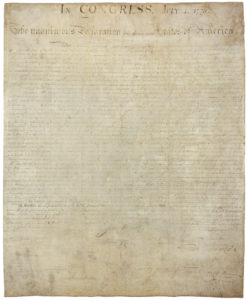 In Congress, July 4, 1776. The unanimous Declaration of the thirteen united States of America. When in the Course of human events, it becomes necessary for one people to dissolve the political bands which have connected them with another, and to assume among the powers of the earth, the separate and equal station to which the Laws of Nature and of Nature’s God entitle them, a decent respect to the opinions of mankind requires that they should declare the causes which impel them to the separation.
In Congress, July 4, 1776. The unanimous Declaration of the thirteen united States of America. When in the Course of human events, it becomes necessary for one people to dissolve the political bands which have connected them with another, and to assume among the powers of the earth, the separate and equal station to which the Laws of Nature and of Nature’s God entitle them, a decent respect to the opinions of mankind requires that they should declare the causes which impel them to the separation.
We hold these truths to be self-evident, that all men are created equal, that they are endowed by their Creator with certain unalienable Rights, that among these are Life, Liberty and the pursuit of Happiness.–That to secure these rights, Governments are instituted among Men, deriving their just powers from the consent of the governed, –That whenever any Form of Government becomes destructive of these ends, it is the Right of the People to alter or to abolish it, and to institute new Government, laying its foundation on such principles and organizing its powers in such form, as to them shall seem most likely to effect their Safety and Happiness….
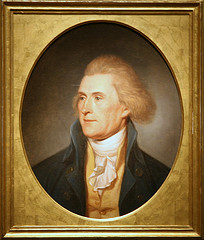 This document is literally over-the-top amazing! In that much younger world, in which no united people anywhere on the face of this earth had ever before that sacred date been free from a strong, overbearing, often brutal, and always highly fallible government of and by the very few, our Declaration of Independence does not only declare our colonies’ separation from Great Britain. Also, and very far more importantly, for the first time in history, our Declaration of Independence claims FOR EACH OF THE PEOPLE INDIVIDUALLY who were living in these colonies a whole new human reality! It sets forth the overriding principle that ONLY THE PEOPLE have the power and the right to rule themselves, individually! And furthermore, if the people as individuals are ever not happy with their government, then it is their absolute and unfettered right as individuals to peacefully change their government, whenever and however they like. In colonies in which some people were still being held as slaves by other people, it also sets forth the overriding principle that all men are created equal! And to deny slaveholders the right to declare other human beings to be their property, this document revises what had always until then been the standard mantra of rights from “life, liberty, and property”, and instead it proclaims our universal rights now to be “Life, Liberty, and the pursuit of Happiness”. This seems actually to invite those still being held as slaves in the American colonies to claim the great happiness of their own freedom, and it urges them to make that claim just as soon as they can manage it.
This document is literally over-the-top amazing! In that much younger world, in which no united people anywhere on the face of this earth had ever before that sacred date been free from a strong, overbearing, often brutal, and always highly fallible government of and by the very few, our Declaration of Independence does not only declare our colonies’ separation from Great Britain. Also, and very far more importantly, for the first time in history, our Declaration of Independence claims FOR EACH OF THE PEOPLE INDIVIDUALLY who were living in these colonies a whole new human reality! It sets forth the overriding principle that ONLY THE PEOPLE have the power and the right to rule themselves, individually! And furthermore, if the people as individuals are ever not happy with their government, then it is their absolute and unfettered right as individuals to peacefully change their government, whenever and however they like. In colonies in which some people were still being held as slaves by other people, it also sets forth the overriding principle that all men are created equal! And to deny slaveholders the right to declare other human beings to be their property, this document revises what had always until then been the standard mantra of rights from “life, liberty, and property”, and instead it proclaims our universal rights now to be “Life, Liberty, and the pursuit of Happiness”. This seems actually to invite those still being held as slaves in the American colonies to claim the great happiness of their own freedom, and it urges them to make that claim just as soon as they can manage it.
This extraordinary preamble to the Declaration of Independence is followed by a long list of the colonists’ grievances against the British king, the most prominent of which in the first draft of the Declaration of Independence is this:
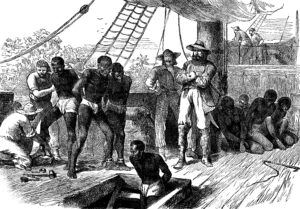 He (the British King) has waged cruel war against human nature itself, violating it’s most sacred rights of life & liberty in the persons of a distant people who never offended him, captivating & carrying them into slavery in another hemisphere, or to incur miserable death in their transportation thither. this piratical warfare, the opprobrium of infidel powers, is the warfare of the CHRISTIAN king of Great Britain. determined to keep open a market where MEN should be bought & sold, he has prostituted his negative for suppressing every legislative attempt to prohibit or to restrain this execrable commerce: and that this assemblage of horrors might want no fact of distinguished die, he is now exciting those very people to rise in arms among us, and to purchase that liberty of which he has deprived them, & murdering the people upon whom he also obtruded them; thus paying off former crimes committed against the liberties of one people, with crimes which he urges them to commit against the lives of another.
He (the British King) has waged cruel war against human nature itself, violating it’s most sacred rights of life & liberty in the persons of a distant people who never offended him, captivating & carrying them into slavery in another hemisphere, or to incur miserable death in their transportation thither. this piratical warfare, the opprobrium of infidel powers, is the warfare of the CHRISTIAN king of Great Britain. determined to keep open a market where MEN should be bought & sold, he has prostituted his negative for suppressing every legislative attempt to prohibit or to restrain this execrable commerce: and that this assemblage of horrors might want no fact of distinguished die, he is now exciting those very people to rise in arms among us, and to purchase that liberty of which he has deprived them, & murdering the people upon whom he also obtruded them; thus paying off former crimes committed against the liberties of one people, with crimes which he urges them to commit against the lives of another.
Of course, this tirade against slavery was not allowed to remain in the Declaration of Independence. Indignant representatives of the Southern slave-holding states removed it right away. But those same Southerners missed the anti-slavery nuances that the Declaration’s clever principal author had hidden in the Declaration’s preamble, so there those words remained. And that principal author of the Declaration of Independence was a Southerner himself, and someone who had inherited hundreds of slaves. He was thirty-three-year-old Thomas Jefferson. The same Thomas who, soon after he later finished one final earth-incarnation as a Welsh farmer, which he tells me that he took in order to “get back into balance” after his extraordinary Thomas Jefferson lifetime, he then became my spirit guide. My Thomas now co-authors these weekly blog posts, and while he is not any longer Thomas Jefferson – more on that later – the way Jefferson got so much anti-slavery language into the Declaration of Independence right under the Southern slaveholders’ noses still to this day makes my Thomas smile.
 Long before I knew that Thomas was my spirit guide, he guided me in researching and writing an accurate account of Thomas Jefferson’s ten-year marriage to Martha Wayles Skelton, which marriage neatly spanned the Revolutionary War. Thomas and Martha were married on January 1, 1772, and it truly was a love-match. But Patty – her nickname – was repeatedly pregnant, and she became ever more sickly with each child she bore. Her father was an importer of slaves, and her mother had died young, so Betty Hemings, her father’s half-white slave mistress, and the woman who had raised Patty, had made of Jefferson’s future wife into an adamant abolitionist. And so, apparently, was Thomas Jefferson a pretty ardent abolitionist as well, at least while his adored wife was alive. Thanks to Jefferson, the colony of Virginia became the first place on earth to ban the importation of slaves, even before Great Britain did it. And we have seen above what Jefferson did with the first draft of the Declaration of Independence! In fact, my research at Monticello suggests that he was starting to plan to make abolition the great cause of the rest of his life. Jefferson made it clear in his contemporary writings that as soon as the Revolutionary War ended, he meant to retire “to my family, my farm, and my books.”
Long before I knew that Thomas was my spirit guide, he guided me in researching and writing an accurate account of Thomas Jefferson’s ten-year marriage to Martha Wayles Skelton, which marriage neatly spanned the Revolutionary War. Thomas and Martha were married on January 1, 1772, and it truly was a love-match. But Patty – her nickname – was repeatedly pregnant, and she became ever more sickly with each child she bore. Her father was an importer of slaves, and her mother had died young, so Betty Hemings, her father’s half-white slave mistress, and the woman who had raised Patty, had made of Jefferson’s future wife into an adamant abolitionist. And so, apparently, was Thomas Jefferson a pretty ardent abolitionist as well, at least while his adored wife was alive. Thanks to Jefferson, the colony of Virginia became the first place on earth to ban the importation of slaves, even before Great Britain did it. And we have seen above what Jefferson did with the first draft of the Declaration of Independence! In fact, my research at Monticello suggests that he was starting to plan to make abolition the great cause of the rest of his life. Jefferson made it clear in his contemporary writings that as soon as the Revolutionary War ended, he meant to retire “to my family, my farm, and my books.”
But all of that was not to be. Patty’s illness was diabetes, and in September of 1782, just as the Revolutionary War was winding down, she delivered her last child, Lucy, and four months later Patty died with her husband at her side, at the age of just 34. Jefferson never really was the same man again. And he burned all their letters to one another, and all her personal papers, no doubt to protect her from the judgment of those who might not share her fiercely abolitionist views.
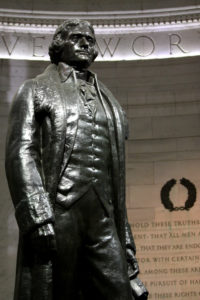 Martha Jefferson’s death may have had major historical ramifications. Before her death, it was her husband’s clear intention to devote the rest of his life to the abolition of slavery in the nation that he had helped to found. The primary problem was that racism was rampant, so whenever slaves were freed, they were horribly treated. Jefferson’s first sympathetic thought, to offer to send the slaves back to their native countries, would never have worked because they had been here for generations. So, by the time of Patty’s death, Jefferson was looking at experimenting with how we might do a proper emancipation by giving the newly freed slaves their own state initially, where they could live on farms checker-boarded with farms owned by sympathetic white farmers in the still-wild interior perhaps, and people could get to know one another and come together gradually, peacefully, and with appropriate Christian customs and supports in place. Personally, I have no doubt that if fixing this racial problem had become his and a healthy Patty’s whole life’s goal, they could have fixed it all by, perhaps, 1820 or so. Then there would have been no American Civil War. And no ongoing Jim Crow racial strife for most of the whole century thereafter. Then Thomas Jefferson would be known only for his Declaration of Independence, and for his brilliance in having so well and properly freed the slaves and created the healthily race-blind United Stated that we are blessed with only now, 250 years later. But instead, that poor man fled Monticello for decades after his wife’s death. He helped to negotiate the peace in France. He then became the first Secretary of State, the second Vice President, and the third President of the United States. Thomas Jefferson was a great American Founding Father, but it was a consolation life, and not the life he had wanted.
Martha Jefferson’s death may have had major historical ramifications. Before her death, it was her husband’s clear intention to devote the rest of his life to the abolition of slavery in the nation that he had helped to found. The primary problem was that racism was rampant, so whenever slaves were freed, they were horribly treated. Jefferson’s first sympathetic thought, to offer to send the slaves back to their native countries, would never have worked because they had been here for generations. So, by the time of Patty’s death, Jefferson was looking at experimenting with how we might do a proper emancipation by giving the newly freed slaves their own state initially, where they could live on farms checker-boarded with farms owned by sympathetic white farmers in the still-wild interior perhaps, and people could get to know one another and come together gradually, peacefully, and with appropriate Christian customs and supports in place. Personally, I have no doubt that if fixing this racial problem had become his and a healthy Patty’s whole life’s goal, they could have fixed it all by, perhaps, 1820 or so. Then there would have been no American Civil War. And no ongoing Jim Crow racial strife for most of the whole century thereafter. Then Thomas Jefferson would be known only for his Declaration of Independence, and for his brilliance in having so well and properly freed the slaves and created the healthily race-blind United Stated that we are blessed with only now, 250 years later. But instead, that poor man fled Monticello for decades after his wife’s death. He helped to negotiate the peace in France. He then became the first Secretary of State, the second Vice President, and the third President of the United States. Thomas Jefferson was a great American Founding Father, but it was a consolation life, and not the life he had wanted.
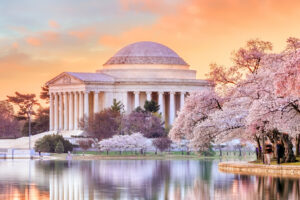 When I researched My Thomas at Monticello, I discovered that Jefferson had been a rather surprising slaveholder. He had inherited this institution that he deeply hated, and for much of his life, emancipation was not even legal in Virginia. So his hundreds of inherited people lived communally with him at Monticello on family plots where they grew vegetables that they then sold to their master’s kitchen. Yes, really! And since Jefferson often didn’t have the cash to pay them right away, he would keep account books, which I saw, listing what he owed to his slaves for their vegetables. They had Sundays off, and often Saturdays too, except in harvest season, when everyone had to work all seven days. Their overseer was himself a slave, since white overseers would treat slaves like, you know, actual slaves. There is no record of Jefferson’s ever allowing a slave to be beaten or mistreated, except for once, in his old age, when he allowed it for an insufferable young man. But just that once upset him so much that he never allowed it again.
When I researched My Thomas at Monticello, I discovered that Jefferson had been a rather surprising slaveholder. He had inherited this institution that he deeply hated, and for much of his life, emancipation was not even legal in Virginia. So his hundreds of inherited people lived communally with him at Monticello on family plots where they grew vegetables that they then sold to their master’s kitchen. Yes, really! And since Jefferson often didn’t have the cash to pay them right away, he would keep account books, which I saw, listing what he owed to his slaves for their vegetables. They had Sundays off, and often Saturdays too, except in harvest season, when everyone had to work all seven days. Their overseer was himself a slave, since white overseers would treat slaves like, you know, actual slaves. There is no record of Jefferson’s ever allowing a slave to be beaten or mistreated, except for once, in his old age, when he allowed it for an insufferable young man. But just that once upset him so much that he never allowed it again.
 When, in 2015, my spirit guide came out to me as having been Thomas Jefferson in an earlier lifetime, I had just one question for him. You may well know what it was. I had done enough research to be confident that the Sally Hemings children who had Jefferson DNA had been fathered by Thomas’s younger brother, Randolph, and not by Thomas himself; but I wanted to know that from him directly. My Thomas insisted that I must ask Thomas Jefferson himself that question. So that next night, while my body slept, Thomas whisked me to the astral plane, and to a small eighteenth-century-style reception room, where stood Thomas Jefferson himself. Wow! Picture this! Two tall men, Jefferson wearing his eighteenth-century garb for me, and my Thomas, even taller and in his long blue sixth-level robe and his Fu Manchu mustache. We recognize people in the astral plane by their spiritual vibrations, and these two vibrated almost identically, although Thomas did vibrate a bit higher and more rapidly than did Jefferson. But, notice that they are two different beings now! I find that fascinating! When I am in my astral body, I think I look as I did when I was about thirty years old, with long hair. Thomas nudged me to ask my question, so I did that, shyly.
When, in 2015, my spirit guide came out to me as having been Thomas Jefferson in an earlier lifetime, I had just one question for him. You may well know what it was. I had done enough research to be confident that the Sally Hemings children who had Jefferson DNA had been fathered by Thomas’s younger brother, Randolph, and not by Thomas himself; but I wanted to know that from him directly. My Thomas insisted that I must ask Thomas Jefferson himself that question. So that next night, while my body slept, Thomas whisked me to the astral plane, and to a small eighteenth-century-style reception room, where stood Thomas Jefferson himself. Wow! Picture this! Two tall men, Jefferson wearing his eighteenth-century garb for me, and my Thomas, even taller and in his long blue sixth-level robe and his Fu Manchu mustache. We recognize people in the astral plane by their spiritual vibrations, and these two vibrated almost identically, although Thomas did vibrate a bit higher and more rapidly than did Jefferson. But, notice that they are two different beings now! I find that fascinating! When I am in my astral body, I think I look as I did when I was about thirty years old, with long hair. Thomas nudged me to ask my question, so I did that, shyly.
Thomas Jefferson smiled gently at me. He could see that I was embarrassed to be asking him such a personal question. Then he said in his beautiful soft, southern voice, “I could not have been intimate with Sally Hemings because she was my property so she could not have consented.” And I thanked him. What could I say? Above all, the man was a gentleman.
My dear ones, what Thomas Jefferson and his American generation of giants did most of all was to present to humankind for the first time in human history the notion that each man has the precious right to govern himself. That is why our Declaration of Independence and its upcoming 250th anniversary are so important, and not just to Americans, but really to all the world. Government must not be from the top, working too often for just a greedy few; but really, it can only be by each of us, working together, for the good of us all.
O beautiful for patriot dream
That sees beyond the years
Thine alabaster cities gleam,
Undimmed by human tears!
America! America!
God shed His grace on thee,
And crown thy good with brotherhood
From sea to shining sea!
– Katharine Lee Bates (1859-1929), from “America the Beautiful” (1893)
(Many photos are from Vecteezy.com)
A lovely post, Mrs. Grimes. I have long since read “My Thomas” and am pleased to read your references to it in today’s article. My best regards to you for your courage expressed in your books and to Mr. Jefferson for his sacred work on behalf of the establishment of freedom for what became the United States. My prayer is that our Founding Fathers will continue to work with the people of the USA to inspire them to uphold our God given sacred constitution.
My very dear Elaine, thank you so much for your wonderful comment here! My Thomas, the book, was first published by Doubleday in 1993, and it has been out of print for a while, but we have just now decided to put out a new edition to honor the 250th anniversary of the signing of the Declaration of Independence, which will be next July 4th. Oh my dear one, I do so very much join you in your prayer for this nation!